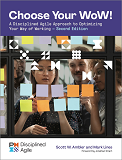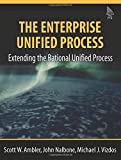Amalgamated Diagrams of the Enterprise Unified Process
Enterprise Architecture discipline. It is the combination of the workflow activity diagram of Figure 2 and the workflow details diagrams of Figure 3, Figure 4, Figure 5, Figure 6, and Figure 7. The amalgamated workflow diagram has several characteristics:
- It presents a good overview of the discipline. The diagram capture the critical aspects of the detailed workflow diagrams — the roles, activities, and artifacts — but doesn’t show the interfaces with other disciplines.
- It avoids the potentially serial nature of the workflow activity diagram. Although Figure 2 isn’t so bad, many people often make the mistake of wanting to follow the activities of a discipline in serial order when in fact they should be performed iteratively.
- It doesn’t preclude the other diagrams. It is perfectly fine to show the workflow details diagrams when needed. In many ways, the amalgamated diagram of Figure 1 is a suitable replacement for Figure 2.
Figure 1. The amalgamated workflow diagram for the Enterprise Architecture discipline.

Figure 2. The Enterprise Architecture workflow.

Figure 3. The Define Architectural Requirements workflow details.

Figure 4. The Define Candidate Architecture workflow details.

Figure 5. The Refine Enterprise Architecture workflow details.

Figure 6. The Define Reference Architecture workflow details.

Figure 7. The Support Development Teams workflow details.

Recommended Reading
 |
This book, Choose Your WoW! A Disciplined Agile Approach to Optimizing Your Way of Working (WoW) – Second Edition, is an indispensable guide for agile coaches and practitioners. It overviews key aspects of the Disciplined Agile® (DA™) tool kit. Hundreds of organizations around the world have already benefited from DA, which is the only comprehensive tool kit available for guidance on building high-performance agile teams and optimizing your WoW. As a hybrid of the leading agile, lean, and traditional approaches, DA provides hundreds of strategies to help you make better decisions within your agile teams, balancing self-organization with the realities and constraints of your unique enterprise context. This book represents leading-edge thinking about enterprise agile, some of which originated in the EUP and RUP. |
 |
This book, The Enterprise Unified Process: Extending the Rational Unified Process, defines the Enterprise Unified Process® (EUP), which was first introduced by myself in 1999 and later enhanced to support a wider variety of clients. The EUP is an extension to the IBM Rational Unified Process (RUP). The EUP extends the RUP to include the operation and support of a system after it is in production and its eventual retirement. Furthermore, because all but the smallest organizations have more than one system, the EUP also handles cross-system enterprise issues such as portfolio management, enterprise architecture, and strategic reuse. |
